#large-scale fabric sculptures
Explore tagged Tumblr posts
Photo

Home Reframed
“The word home has many meanings,” writes Museum of the Home, a London-based gallery space which, since 2011, has been dedicated to the changing shape of domestic interiors over time. “It can be the physical space we live in, or a feeling that goes beyond a specific time or place.” Do Ho Suh (b. 1962) is a South Korean artist whose practice centres around these questions. Since the 1990s, Suh has become known for crafting large-scale fabric sculptures that recreate the places in which he has lived and worked. These pieces vary from small, singular household objects – door handles, plugs switches and light bulbs – through to full scale replicas of architectural spaces, apartments, staircases and hallways.



#do ho suh#artist#art#south korean artist#home reframed#museum of the home#large-scale fabric sculptures#sculptures
1 note
·
View note
Text




residency studio photos from the last week. top left is woven text that says 'sacred' and top right is embroidered text that says 'the grid extends to infinity' which is a quote from rosalind krauss's 1979 essay 'grids' where she writes: "logically speaking, the grid extends, in all directions, to infinity. any boundaries imposed upon it by a given painting or sculpture can only be seen -according to this logic- as arbitrary. by virtue of the grid, the given work of art is presented as a mere fragment, a tiny piece arbitrarily cropped from an infinitely larger fabric. thus the grid operates from the work of art outward, compelling our acknowledgement of a world beyond the frame."
bottom left is cotton dyed in european ash with copper sulphate and bottom right is my current large scale tapestry weaving project
457 notes
·
View notes
Text
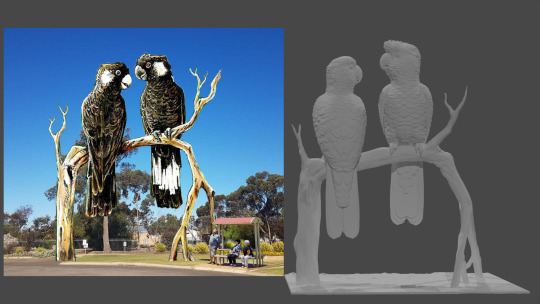
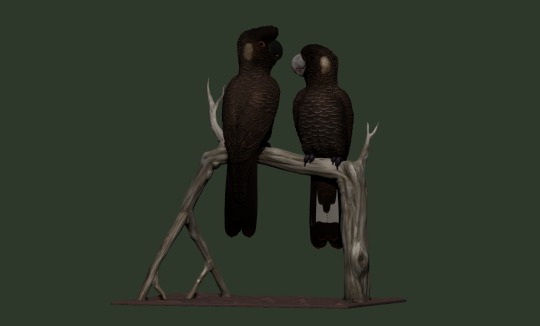
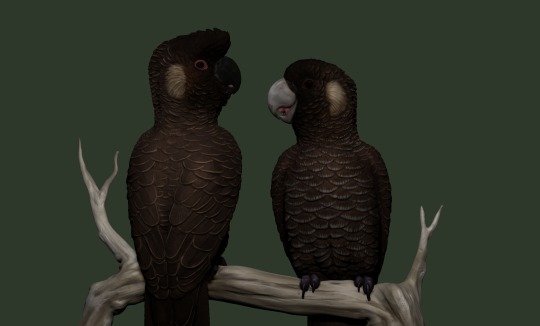
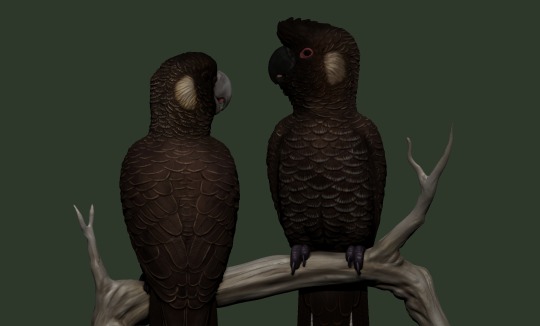

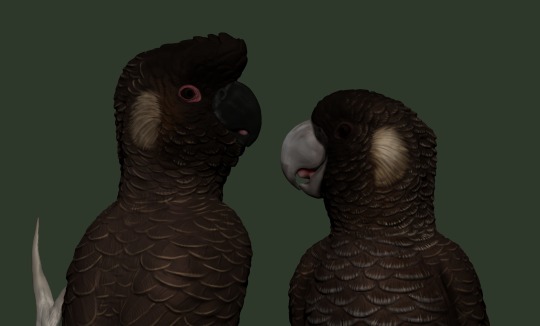
Designing the Carnaby Cockatoo Sculpture: A Monumental Achievement
Hello, everyone!
I'm overjoyed to share with you the most significant and fulfilling project I've worked on to date. I had the honor of designing a Carnaby Cockatoo sculpture, a project that holds a special place in my heart.
This sculpture is not just any creation; it's destined to become an 11-meter-tall statue residing in South West Australia, amidst the natural habitat of the Carnaby cockatoos. The journey from concept to handover has been a several months in the making, involving meticulous collaboration with the client to bring their vision to life. They envisioned two realistic cockatoos perched on a gumtree branch, and with the invaluable guidance of a Carnaby cockatoo specialist, I refined my model to capture the true beauty of these endangered birds.
Receiving the final approval on my model was a moment of pure elation. The design has now been handed over to the fabricators, marking a significant milestone in this journey.
This project was more than a design task; it was a comprehensive learning experience in client-based design. I gained insights into formatting and optimizing models for large-scale production. Sure, there were challenges like dealing with messy geometry and large file sizes, but as the saying goes, the best learning comes from diving into the deep end and adapting as you go.
Thank you all for your continued support and encouragement. This project is a testament to the growth and possibilities that come with embracing new challenges.
#my artwork#sculpture#carnaby cockatoo#parrot sculpture#cockatoos#nomad sculpt#blender#zbrush#3d art
22 notes
·
View notes
Text




Last year Tampa Museum of Art installed work by fashion designer Naeem Khan, including the two pieces above, Floating Flowers Fuchsia and Gold and Floating Flowers Pink and Silver.
From the museum about the work-
As part of its ongoing exhibition series exploring the intersection of art and fashion, the Tampa Museum of Art presents a series of paintings by globally renowned fashion designer Naeem Khan. Khan works independently, as well collaboratively with artist Stanley Casselman as the collective KACE, to create large-scale works inspired by his ongoing exploration of flora, light, and color. Five monumental works, comprised of paint and sequins represent Khan’s inaugural museum exhibition.
The Khan Family, steeped in the tradition of fashion and textiles for over 100 years, is renowned for their atelier in Mumbai and their luxurious couture worn by luminaries and India’s royalty. Khan arrived in New York at the age of 17, travelling to the United States with his father. A business appointment with Halston changed the course of his life as the famed designer decided on the spot that Khan would be his protégé. With Halston as his mentor, Khan became immersed in Manhattan’s art and social circles. From the atelier to Studio 54 and Andy Warhol’s Factory, Khan emerged as a designer at a pivotal moment in the 1970s where the lines between art, fashion, music, film, and celebrity were often blurred, further signifying New York City as the epicenter of creativity.
While working with Halston, Khan met Andy Warhol who frequently collaborated with Halston on his projects. Khan participated in their collaborations by drawing the flowers for their designs, specifically poppies. Warhol, like Halston, took Khan under his wing and once told the young designer, “You shouldn’t hold your pencil that way. Let me show you how to draw.” Flowers, inspired by his work and friendship with Warhol as well as the flora in his home country of India, anchor Khan’s visual language. In 2020, painter Stanley Casselman introduced himself to Khan at one of his fashion shows and was immediately struck by the beauty and power of the designer’s work. Casselman observed that Khan’s designs could be translated into painting. Conversations lead to collaboration and today the two artists work both individually and together under the name KACE. Works, such as Jardin Chrome and Jardin d’Or, feature Khan’s elaborate sequined blooms in concert with Casselman’s gestural paint strokes. The compositions reveal the signature elements of each artists’ practice. Here, Khan’s ornate craftsmanship and Casselman’s abstract mark making unite in dazzling effect.
Khan’s solo works, Floating Flowers Pink and Silver and Floating Flowers Fuchsia and Gold, nod to his familial history with fabric, color, composition, and texture while pushing the boundaries of contemporary painting. Each flower is comprised of hundreds of sequins and beads. Delicately sewn onto silkscreen material, Khan suspends the panels one over the other, creating a sculptural quality to the paintings. Fabricated in a range of petal formations and size, Khan’s blossoms both capture and reflect light. As if suspended in space, the flowers come to life, symbolizing Khan’s creative past and his burgeoning artistic future.
#Naeem Khan#Tampa Museum of Art#Fashion and Art#Art#Art Instalation#Art Shows#Stanley Casselman#Fashion#Fashion Design#Fiber Arts#Florida Art Shows#Flowers#KACE#Sculpture#Sequins#Andy Warhol#TBT
4 notes
·
View notes
Photo










Olga de AmaralColombian, b. 1932
Olga de Amaral weaves horsehair, wool, linen, cotton, gesso, and precious metals—most often gold leaf—into abstract tapestries and sculptures that blur the lines between art and craft. At a distance, many of her pieces evoke glistening mosaics, adobe walls, medieval chainmail, and baroque churches, dramatically reflecting the light that surrounds them. By using gold, Amaral invokes the material’s religious and ceremonial uses in pre-Columbian society—and its plunder by the Spanish and presence in colonial art. Amaral studied architectural drafting in Colombia before completing graduate studies in fabric art at the Cranbrook Academy of Art in Michigan.
At age 22 with a degree in architectural design, Olga de Amaral moved from Bogotá to the United States where she studied fiber art at the Cranbrook Academy of Art in Michigan. She returned to Colombia in 1955, and in 1956 she and her husband, Jim Amaral, opened a workshop of hand-woven textiles. De Amaral's distinctive large-scale abstract woven pieces are often covered in gold and silver leaf, lending them a shimmering, almost sculptural quality in contrast to the feeling of a tapestry. Her richly textured pieces evoke the varied natural landscapes of Colombia as well as ancient pre-Columbian gold artifacts. The artist's architectural background is evident in the precise sculptural quality of her works, but de Amaral says her craft is driven by emotion and that she does not plan for particular patterns to emerge.
https://www.artsy.net/artist/olga-de-amaral
25 notes
·
View notes
Text

ART | "Larry Bell - works from the 1970s" at Hauser & Wirth Monaco
Larry Bell first came to attention as part of the light and space movement in Los Angeles in the 1960s. This exhibition will focus on his architecturally scaled works from the 1970s, known as standing walls. The large scale works in this show are among his most ambitious early works, and follow a rigorous, radical and austere economy of means. They reflect a change in Bell’s work that occurred in the late 1960s when he abandoned the use of metal frames in his sculptures, towards free-standing glass panels joined with silicone, allowing him to work on a much grander scale, determined by the body. This also saw him move away from the pure form of the cube, towards an exploration of architectural and mural geometries, not just squares but corners and zig-zags.
The exhibition will consist of the four large-scale glass sculptures from the early 1970s, along with ‘Moving Ways,’ a monumental late 1970s wall work. These works highlight Bell’s historic contribution to a severely pared down aesthetic and how his work at this stage addresses not just the viewer’s gaze but the perceiving body (Bell’s recourse to corporeal phenomenology), both characteristics that can be allied to minimalism. To signal and compliment the exhibition, a more recent, highly colored glass work will be installed outdoors in the Jardins des Boulingrins adjacent to the gallery, during the course of the exhibition. The rare, museum-quality works that will be shown come primarily from important Italian collections, such as the Panza Collection. This includes the work ‘Untitled’ (1970) which was featured in a key solo exhibition of Bell’s work in Rome in 1974.
Larry Bell, born in Chicago in 1939, is one of the most renowned and influential artists to emerge from the Los Angeles art scene of the 1960s, alongside contemporaries Ed Ruscha and Robert Irwin. Known foremost for his refined surface treatment of glass and explorations of light, reflection and shadow through the material, Bell’s understanding of the potential of glass and light allows him to expand visual and physical fields of perception, and his sculptures to surpass traditional bounds of the medium.
Since 1969, Larry Bell has used his own high-vacuum coating system that allows him to deposit thin metal films onto his glass surfaces, harnessing a little-known technique developed for aeronautics to create a highly original body of work.
Bell’s use of commercial industrial pro-cesses in his studio since the 1960s, demonstrates his unparalleled skill and dedication in each step of his sculptures’ fabrication. He has said: ‘Although we tend to think of glass as a window, it is a solid liquid that has at once three distinctive qualities: it reflects light, it absorbs light, and it transmits light all at the same time.’
In 1978, Larry Bell began experimenting with a modified version of the vacuum coating process, to make his ‘vapor drawings’ on paper. The unique large-scale wall work ‘Moving Ways’ (1978), made from applying aluminum on black paper, comprises five individual drawings hung together to make up a multi-paneled composition. In the ‘vapor drawings,’ Bell controls the density of the metallic coating, much like his glass works, in order to vary degrees of transparency and opacity across their surface. Thus, the drawings emulate and complement the elusive, reflective and spatial qualities that are present in his sculptural works.
Outside in the Jardins des Boulingrins, the major sculpture ‘The Blue Gate’ (2021) will be shown. This much more recent work shows the development of Bell’s practice. This is most apparent though his masterful adoption of color achieved by employing the very different medium of monochrome color-laminated glass. While related to the earlier standing walls in its scale and relation to the body, here the form has also become more complex through the use of contained or intersecting forms and triangular glass panes to create diagonals. This work is comprised of panes of vibrant amethyst purple and peacock blue. These colors overlap revealing a variety of mixed hues through their layers. It shows how Bell delights in colour contrasts and complementarity, as well as their mixing through the special transparency afforded by glass. Displayed in the Mediterranean light that has attracted artists through the centuries, this work will be especially impactful.
Image: Two Glass Walls, 1971-1972, 2 coated glass panels, Larry Bell. Photo: Gian Sinigaglia, Felicity Samuel Gallery, London 4 june - 31 august 2024
4 notes
·
View notes
Text
Jessica Stockholder





1. "Vortex in the Play of Theater with Real Passion" (2000)
Materials: Duplo, theater curtain, work site containers, bench, theater light, linoleum, tables, fur, newspaper, fabric, and paint
Description: An installation that merges sculpture and painting with everyday materials, exploring the interplay between abstraction and the domestic sphere.
2. "Wide Eyes Smeared Here Dear" (2009)
Materials: Carpet, furniture, plastic containers, tubular metal structure, hardware, printed photographs, rubber floor tile, velvet curtain, paint.
Description: Immersive installation that combines bright colors with everyday materials like furniture and plastic to create a complex visual and tactile experience.
3. "Flooded Chambers Maid" (2009)
Materials: Wood, carpet, electric lights, plastic containers, and paint
Description: This outdoor installation combines architectural elements with brightly colored objects to challenge perceptions of space and materials.
4. "Sam Ran Over Sand or Sand Ran Over Sam" (2004)
Materials: Aluminum, paint, plastic containers, light fixtures, and everyday objects
Description: A playful assemblage of vibrant colors and textures, combining domestic and industrial materials in a dynamic composition.
5. "Color Jam" (2012)
Materials: adhesive vinyl, vinyl scrim
Description: A large-scale public art piece in downtown Chicago, where intersections were wrapped in vibrant colors, transforming the city streets into an interactive artwork.
2 notes
·
View notes
Text
In college I took multiple art history classes, all with the same professor.
One focusing on Buddhist, Islamic, and Hindu architecture sticks out to me because my professor showed us a photo of a temple carved into the walls of a valley with incredibly large full-body sculptures between pillars.
And she told us she had taken those photos on a trip she had taken as part of her studies.
And then she told us she wishes we could see it. The mere sense of scale was breathtaking. The art had been preserved and upkept so well you could still see individual folds and fibers in the fabric.
She then said she was happy she went the year she did as the site no longer exists and was destroyed by USAmerican bombs shortly after her visit.
The room was silent. For a lot of the students there, I think it was the first time they had considered that cultural death and genocide was possible. While numbers of "enemy combatants" killed was one thing, seeing someone show you before and after of something that existed and was carefully maintained for hundreds of years is another. Destroyed in an instant.
And I see the news of sites being destroyed in Palestine. And I think about my art history professor. And I wonder how she can continue to teach about these things not knowing if they'll exist next month.
But someone has to say they exist, and they matter, and centuries of upkeep and continued tradition can't be erased that easily.
And I hope to see a free Palestine, one that can restore and rebuild. And I know my professor still tears up talking about these lost cultural touchstones for people she hasn't met. And I know people care.
2 notes
·
View notes
Text
"I want to listen to a song", the young dragon demands. Comfortably sinking into soft pillows and expensive sheets, a stray thought crosses his mind. A fragment of memory of home, of luxuries he had left behind. Diamont can understand Florence's hesitation on parting with such a life now that he knows it. In a sense, perhaps Dia is the same. "You are meant to teach me, but now I want to listen." Florence should also know that the option between acquiescing to Diamont's demands is to be subjected to increasingly pointed questions, to indulge in his endless curiosity. "You have been busy with managing the group at large, and I..." They had returned after a long trip. "I will study after. I promise."
From his own spot among another pile of impossibly soft pillows covered only by a few sheets, there's no noise at first but the gentle turning of a page. The man, displaced from the comforts of his bed, does not offer much of an acknowledgement after Diamont makes his demands; then there is a slithering sound, a long trail of scales against fabric, the rustling of unbound hair. A deep, throaty laugh as the nephilim man rises slowly from his spot, used tot he demands of higher powers even when he lays at rest.
But Diamont asks him a simple thing, a thing that he is long passionate for, to indulge in the arts, to play music until his fingers ached and to play just a little more after that. "I normally charge a considerable fee for such demands." But for you, Florence does not say, it is free. It is free, it is free so that it may chase the ills of your mind to a different place. So it may give you rest. It is free because he knows, on some level, an intimacy. A familiarity. The sort of deep running scar they share on their person, invisible to any but each other. He takes his time slow, and sweet. Arranges the tiny room to be a far crying echo of one of his many private stages and not once does he pay Diamont mind, lets the man rest as he is, before Florence takes his seat on the chair he has long taught is not for idle sitting, but for playing. He teaches that some tools must be left for only specific purposes, to allow the mind to see them as only that, to allow ones self to treat this and that as different entities.
Florence arranges himself prettily, for an audience of one who does not see him, but pride tells him to. Pride makes him obey the strangest of whim. It makes him bend and break in bizarre ways for an art form that does not reciprocate his efforts, because it cannot. But perhaps his audience can, in some way, appreciate the efforts before Florence rests his harp in his arms; the faded edges the fae sculptures fitting perfectly in the same spot they've nestled in for years; gentle friction wearing details and paint to a fine, smooth polish. The nephilim does not speak, allows them both the indulgence of silence as he plucks at strings and readjusts, warms his hands and fingers for proper work. Florence does not ask Diamont for what to play but instead returns to his oldest, and most trusted, of the trade.
Songs of deep melancholia; born from a person that Florence has long put in her grave, longing and hopelessness give voice through music. In the back of his mind, the man remembers the notes, the chords, what every pluck and flick is supposed to mean. A song that was deeply meaningful, but not something that interested others, it did not bring coin to his hand, nor food to his mouth.
The privileged do not care for sadness, lest they get to glimpse it from afar. Music was too skilled at ripping into the core of a man and leaving him bleeding for all to watch. He'd learned quickly to change his tune. But here he plays, earnestly, before the songs switch and switch and switch again; from melancholy to joy to madness, to a passionate calm. As he plays something joins the sounds: the taste of magic lays thick on the tongue, scents the air with something sweet like honey yet deeply floral. It rests at the tip of the tongue ready to be uttered, to be unleashed, and yet Florence restrains himself; something about this cannot be called upon for some reason or another.
Instead he plays, and he plays. His fingers dance about the harp with elegance and patience, Florence lets sounds escape him as his focus hones in only to the movement, to the comfort of it all. He becomes little more than a cascade of pinks and reds; all of him flowing to the tune of something greater than himself.
He lets himself play and play and play, until his fingers ache, and he plays more after that with a smile.
3 notes
·
View notes
Text
Childish Things: Exhibition, Edinburgh Fruitmarket Cur. David Hopkins

Susan Hiller, An Entertainment, 1990
Susan Hiller (1940-2019) is a US-born, British conceptual artist who lived in London, United Kingdom. Her practice spanned a range of media including installation, video, photography, painting, sculpture, performance, artist's books and writing. A key figure in British art, she was best known for her innovative large-scale multimedia installations, and for works that took as their subject matter aspects of culture that were overlooked, marginalised, or disregarded.
'An Entertainment' is comprised of a video and sound installation including four synchronised recordings of scenes from ‘Punch and Judy’ puppet shows. The video is purposefully edited to expose the domestic abuse masquerading as children’s entertainment.

Jeff Koons, Bear and Policeman, 1988
Jeff Koons (1955) is an American artist recognized for his work dealing with popular culture and his sculptures depicting everyday objects, including balloon animals produced in stainless steel with mirror-finish surfaces.
In 'Bear and Policeman', an object that might be found in a childs bedroom is enlarged to be life-sized and is no longer confined to a shelf, but now looms over the viewer and his companion - a policeman.
"The relatively diminutive constable, a symbol of authority, contrasts comically with the bear's monstrous size and relative harmlessness. Looking helplessly up at the bear, the expression on the policeman's face holds the key to enjoying Koons' work: a temporary suspension of adulthood, a return to seeing the world through a child's perspective. Koons seems to hint that the adult world, with its explicit content, greed and shame, is worth staving off." - Angelina Krahn, Art writer

Robert Gober, Playpen, 1986
Robert Gober (1954) is an American sculptor. His work is often related to domestic and familiar objects such as sinks, doors, and legs.
In 'Playpen', the work is remade from an object from his childhood. Ironically the playpen contains no toys to play with and does not intrinsically look like an object designed for playing in. Represents both a prison and a safe haven, a historic artefact and an entire world for a child

Louise Bourgeois, Oedipus, 2003
Louise Bourgeois (1911-2010) was a French-American artist best known for her large-scale sculpture and installation art. Bourgeois was also a prolific painter and printmaker.
The work was inspired by a statue in Bourgeois’ school. The artist’s fascination began with her misunderstanding of its meaning ‘i know they thought it portrayed the good daughter helping her blind father. However, whenever I saw the sculpture it looked to me like the incestuous father hitting upon his daughter and therefore an odd choice for a girl’s school’. The artist's rendition in fabric relates to her childhood, growing up with a family who restored tapestries and was drawn to the story of Oedipus and Freud’s theories because of her own family conflicts.
2 notes
·
View notes
Text
Cornelia Parker's Transitional Object (PsychoBarn)
Exhibition Overview A large-scale sculpture by acclaimed British artist Cornelia Parker, inspired by the paintings of Edward Hopper and by two emblems of American architecture—the classic red barn and the Bates family's sinister mansion from Alfred Hitchcock's 1960 film Psycho—comprises the fourth annual installation of site-specific works commissioned for The Met's Iris and B. Gerald Cantor Roof Garden. Nearly 30 feet high, the sculpture is fabricated from a deconstructed red barn and seems at first to be a genuine house, but is in fact a scaled-down structure consisting of two facades propped up from behind with scaffolding. Simultaneously authentic and illusory, Transitional Object (PsychoBarn) evokes the psychological associations embedded in architectural spaces. It is set atop The Met, high above Central Park—providing an unusual contrast to the Manhattan skyline.
Source: The Met
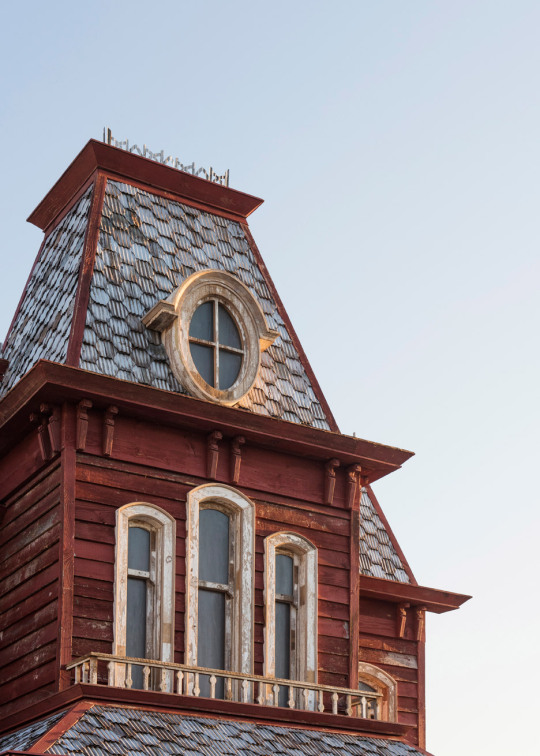
As a site-specific installation at the Met, one of the most visited museums in the world, it's easy to lean into pure spectacle. Parker does this without being vapid, using it precisely to poke at America's obsession with spectacle, especially in politics. Weaving together American references (Hopper, the classic horror Psycho, and the red barn) she does so seamlessly with this comically horrific amalgamation while also acknowledging her position as a Briton connected to the US by mirroring Hitchcock's assimilation into Hollywood.

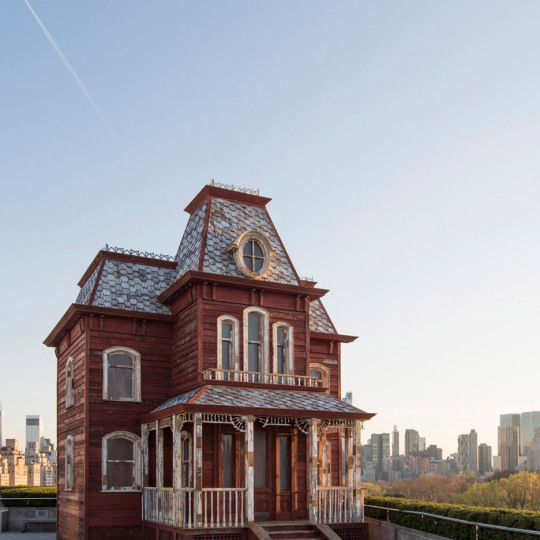
It's all a facade...
Parker's house is red from appropriating the materials of a dismantled barn. The structure disrupts the New York skyline but also screams (psychological) Americana.
The creative process behind the sculpture revels in research; from Dutch barns to the artist's affinity for pop culture. Parker translates her unease stemmed from an unstable political climate (this was in 2016, right before Trump was elected) through humour. I am trying to find this magic (for lack of a better term), this intersection of intention and everything else falling into pieces as if by fate.
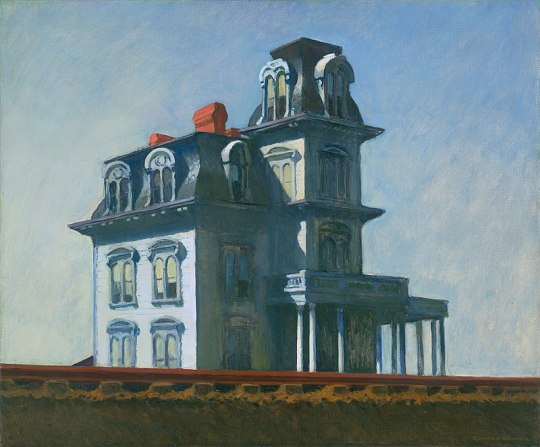
Edward Hopper. House by the Railroad. 1925.
Source: The Met
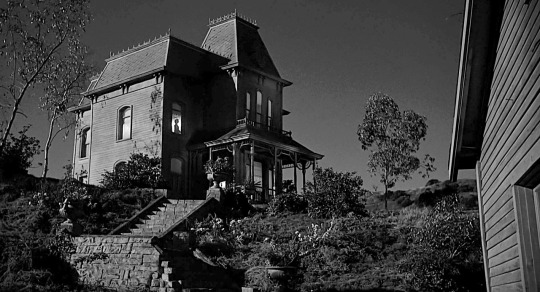
The Bates house from the film Psycho. 1960. Dir. Alfred Hitchcock.
Source: Universal City
2 notes
·
View notes
Text
Esther Mahlangu's artistic style and cultural influence make her a unique artist. While it is difficult to find artists who share the exact combination of her distinctive Ndebele-inspired aesthetic and cultural context, there are artists whose work exhibits similarities or resonates with certain aspects of her art. Here are a few artists who explore themes of cultural heritage, vibrant colors, and geometric patterns, which may evoke a sense of affinity with Esther Mahlangu:
Nelson Mukhuba - A South African artist known for his colorful geometric patterns and contemporary interpretations of Venda culture.
Billie Zangewa - A South African artist who incorporates vibrant textiles, storytelling, and personal narratives to explore themes of identity and womanhood.
Firelei Báez - A Dominican-American artist whose work often involves intricate patterns, cultural references, and explorations of identity, memory, and history.
Wangechi Mutu - A Kenyan-American artist who combines collage, painting, and sculpture to explore themes of African identity, femininity, and cultural mythology.
El Anatsui - A Ghanaian sculptor renowned for his large-scale installations made from recycled materials, which resemble vibrant tapestries and evoke the traditions and history of West Africa.
Yinka Shonibare CBE - A British-Nigerian artist known for his use of African fabrics, vibrant colors, and historical references to explore themes of colonialism, globalization, and cultural identity.
While these artists may share certain resonances with Esther Mahlangu's work, it's important to note that each artist has their unique artistic voice and cultural context. They contribute to the rich diversity and ongoing dialogue within the contemporary art world, celebrating and exploring different aspects of cultural heritage, identity, and artistic expression.
3 notes
·
View notes
Text

On Thursday afternoon, I finished threading fabric onto my wire, and joined the end to form it into a continuous loop. I then spoke to Mike Fox about the potential for this piece, as well as the differences between an introverted and extroverted sculpture- do I want the piece to draw people in, or do I want the piece to intrude out into space?

We both agreed that it would be a good idea for me to create a large scale drawing of the sculpture before continuing, in order to best understand the forms and shapes involved. I think best through drawing.


After finishing my drawing, I decided to reposition the sculpture and draw this new composition over the top of my first drawing. I felt that this would capture its sprawling nature best and make the form less easy to track with the eye. I smudged the chalk as I went, echoing the spiralling forms.

2 notes
·
View notes
Text
Table Lamps That Turn Dull Corners into Stylish Focal Points
Introduction
Illumination is more than a mere functional necessity — it is an art form that can redefine spaces, infusing them with warmth, character, and an undeniable aesthetic appeal. Among the most transformative lighting fixtures, table lamps possess an unparalleled ability to revitalize uninspired corners, converting them into refined focal points. The right selection of Table lamps can bring not only illumination but also a touch of personality, elegance, and cohesion to an otherwise overlooked space.
The Art of Strategic Lighting Placement
Lighting, when curated thoughtfully, transcends its utilitarian purpose and emerges as a crucial element in interior design. A dimly lit corner can project an aura of neglect, while a well-placed table lamp can turn it into an inviting and dynamic feature within a room. The interplay of shadows and highlights creates depth, adding dimension to even the smallest spaces. By introducing contemporary table lamps, homeowners can sculpt an ambient glow that complements both modern and traditional aesthetics.
Curating Aesthetic Elegance with Table Lamps
Table lamps serve as miniature sculptures, imbuing interiors with refined artistry. From ornate bases to sleek, minimalist silhouettes, they encompass a spectrum of styles, each contributing uniquely to a room’s overall aesthetic. For those drawn to classic refinement, luxury lamps with gilded finishes and intricately designed bases can impart a regal charm. Meanwhile, for those embracing a modernist approach, contemporary table lamps with geometric forms and understated elegance can serve as subtle yet powerful statement pieces.
Beyond their stylistic versatility, table lamps function as mood enhancers. A soft, warm glow exuding from a finely crafted lamp cultivates an atmosphere of relaxation, making a space feel instantly more welcoming. The diffusion of light through high-quality fabric shades or frosted glass filters allows for an enchanting interplay of illumination that is neither harsh nor overpowering.
Elevating Spatial Harmony with Complementary Lighting
A single lighting fixture rarely suffices in crafting an atmospheric balance. When paired with Floor lamps , table lamps create a layered lighting scheme that eliminates stark contrasts, ensuring seamless illumination. Strategically placed floor lamps online allow light to cascade across vertical planes, while table lamps provide intimate pools of light that enrich horizontal surfaces. This interplay results in a cohesive and well-lit interior, eliminating areas of excessive brightness or shadowy obscurity.
The Fusion of Classic and Contemporary Styles
Integrating table lamps into an interior design scheme does not necessitate rigid adherence to a single stylistic approach. A juxtaposition of styles can yield striking results. Placing a contemporary table lamp beside a vintage furniture piece can establish a compelling contrast, merging the charm of antiquity with the sleekness of modernity. Likewise, an opulent contemporary chandelier suspended above a space can be harmonized with elegant table lamps, resulting in a visually compelling synthesis of grandeur and intimacy.
For those seeking a refined yet dramatic effect, a modern chandelier paired with contemporary table lamps can create a luxurious visual rhythm. The intricate refractive surfaces of a Chandeliers disperse light in dazzling patterns, while table lamps provide concentrated illumination, striking a balance between spectacle and subtlety.
Selecting the Right Table Lamp for Every Space
Choosing the ideal table lamp necessitates consideration of scale, proportion, and function. A large lamp atop a diminutive side table may appear overwhelming, while an undersized lamp on an expansive console could seem disproportionate. Ensuring that the lamp’s height and base complement the surrounding furnishings is essential in maintaining visual equilibrium.
Materiality plays an equally significant role. Table lamps crafted from opulent materials such as marble, crystal, or brass exude a sense of affluence, making them a perfect fit for luxury interiors. Conversely, ceramic, wood, and matte metal finishes lend themselves to a more understated elegance, ideal for contemporary or rustic spaces.
Moreover, the nature of the light emitted should align with the intended atmosphere. Soft, warm lighting fosters a sense of tranquility, making it suitable for bedrooms and reading nooks, while bright, neutral illumination is ideal for workspaces or areas requiring focused visibility.
Transforming Forgotten Spaces into Design Statements
Every home has its share of neglected spaces — those vacant corners that appear devoid of purpose. These seemingly insignificant areas hold untapped potential, awaiting the introduction of a well-chosen table lamp to redefine their aesthetic identity. Whether placed on a side table in a hallway, a nightstand in a bedroom, or a console in a living area, a thoughtfully selected lamp can turn an empty expanse into a design statement.
To heighten the transformative impact, incorporating additional decorative elements — such as framed artwork, sculptural accents, or cascading greenery — can further accentuate the ambiance created by the lamp. The synergy between lighting and decor elevates the visual harmony of the space, establishing an environment that feels both intentional and sophisticated.
The Lasting Impact of Thoughtful Illumination
The influence of table lamps extends beyond aesthetics; it permeates the very essence of a living space. When light is curated with precision, it fosters a sense of comfort, enhances productivity, and enriches the ambiance of a room. The fusion of form and function that table lamps provide is unparalleled, making them an indispensable element in the pursuit of sophisticated interior design.
For those seeking to reimagine their living spaces, investing in premium Lamps is a choice that marries style with practicality. Whether opting for luxury lamps that exude timeless elegance or contemporary table lamps that echo modern sensibilities, the right lighting selection has the power to redefine interiors, transforming even the dullest corners into captivating focal points.
Source URL- https://medium.com/@onestoplighting99/table-lamps-that-turn-dull-corners-into-stylish-focal-points-e8bdc39421bd
0 notes
Text

“Neon Forest”, 2023

“Neon Forest”, 2023, another view

“Red Falls”, 2021
Above are sculptures by Akiko Kotani for the 2023 Florida Prize in Contemporary Art at Orlando Museum of Art.
Kotani’s Red Falls was part of Skyway 20/21 at USF Contemporary Museum, but it was a joy to see it again along with the 2023 sculptures White Falls and Neon Forest.
The museum’s information on the artist and her work-
As a young aspiring artist living in New York, Akiko Kotani discovered the expressive power of textile art while taking a weaving class at the YMCA Manhattan Weaving Workshop. The experience was life changing, leading her to continue her studies in Guatemala, a country with an exceptional textile art tradition. After two years in Guatemala, she returned to the United States to complete her MA in textiles at the Tyler School of Art in 1977.
In 1977 textiles were only beginning to achieve the status as an art form that they currently have in the contemporary art world. At the time the medium was widely associated with traditional and domestic crafts or as part of the fashion and décor industries. That view was starting to change, as demonstrated by the Metropolitan Museum of Art’s acquisition of one of Kotani’s works shortly after her graduation from Tyler. Since then, she has had a distinguished career as an artist exploring a variety of textile practices.
Kotani had been searching for ways to expand the scale of her work when in 2011 she received a grant from the Heinz Endowments and Pittsburgh Foundation which enabled her to pursue that ambition. The result was her first monumentally scaled sculpture, Soft Walls, a precursor of the works seen in the Florida Prize exhibition. Kotani has always used simple and direct methods of weaving and stitching to create her works. For Soft Walls she adopted a loosely woven crochet technique to produce long bands of material cut from white plastic garbage bags. Those bands were then combined to cover large free-standing walls. Kotani’s massive blocks of woven plastic have the elegant simplicity of minimalist sculpture, while the irregular knotting and soft, slumping fabric undermine the austere formalism of the work’s rectilinear shape.
Kotani’s process of crocheting plastic bags and other materials into long bands is an innovative development that has allowed her to create a variety of large-scale sculptural forms. White Falls and Neon Forest use these crocheted bands, draped in different ways to make sophisticated minimalist statements. Both sets of works are made livelier by how they respond to light. The thin plastic of White Falls shimmers like cascading water. The three fifteen-foot-high conical hangings of Neon Forest are a vibrant satin fabric with a sheen that sparkles in light.
Red Falls is a more ominous work. It is designed to come out of a corner, perhaps suggesting a crevice in a cliff or even an open wound. Made with red plastic bags used by hospitals for biological waste, Red Falls expresses Kotani’s concern for the plight of physically abused women. In fact, all Kotani’s work is in some way an expression of her concerns for women. Her use of textiles and the repetitive practice of weaving pays homage to the extraordinary achievements of women throughout history which have typically been undervalued by society.
#akiko kotani#2023 florida prize in contemporary art#orlando museum of art#sculpture#florida art shows#florida artist#art installation#art#art shows
2 notes
·
View notes
Text
Light Metal is Shaping the Future of Metal and Aluminum Works in the UAE
Light Metal is revolutionizing the UAE's construction and design industry with its exceptional metal and aluminum products. Their extensive range of services is designed to cater to residential, commercial, and industrial clients, providing innovative solutions for everything from cast aluminum to custom metal fabrication. The company’s focus on quality craftsmanship, precision, and durability ensures that every project is completed to the highest standard, making Light Metal a preferred choice for architects, builders, and homeowners alike. Discover more about their wide array of offerings at Light Metal UAE.
Aluminum Doors and Windows: A Perfect Combination of Style and Durability
Aluminum doors and windows are an excellent choice for those seeking a balance between style and durability. Light Metal specializes in manufacturing high-quality aluminum doors and windows designed to complement both modern and traditional architectural styles. Their products offer superior resistance to corrosion, high thermal efficiency, and low maintenance, making them an ideal solution for the harsh climate in the UAE. Whether you're upgrading your home or designing a new commercial space, Light Metal’s aluminum doors and windows ensure long-lasting performance. Learn more about their aluminum door and window solutions at Light Metal Doors and Windows.
Corten Steel: Adding a Touch of Elegance to Your Space
Corten steel is a unique material known for its ability to develop a natural rust-like patina over time, giving it a weathered, rustic appearance that enhances any design. Light Metal offers corten steel solutions that are perfect for creating striking architectural elements like sculptures, facades, fences, and landscaping features. With its outstanding durability and ability to withstand the harsh UAE weather conditions, corten steel is an ideal choice for both residential and commercial applications. Explore the artistic potential of corten steel with Light Metal at Corten Steel Products.
Expert Metal Fabrication: Tailored Solutions for Every Project
When it comes to metal fabrication, Light Metal stands out for its ability to deliver tailored solutions that meet the specific needs of each project. From custom railings and gates to structural metal works, their team of experts utilizes advanced fabrication techniques to create high-quality, precision-engineered metal products. Whether you're in need of bespoke metalwork for a residential home or a large-scale commercial project, Light Metal’s skilled craftsmen ensure every piece meets your exact specifications. Learn more about their metal fabrication services at Light Metal Metal Fabrication.
0 notes